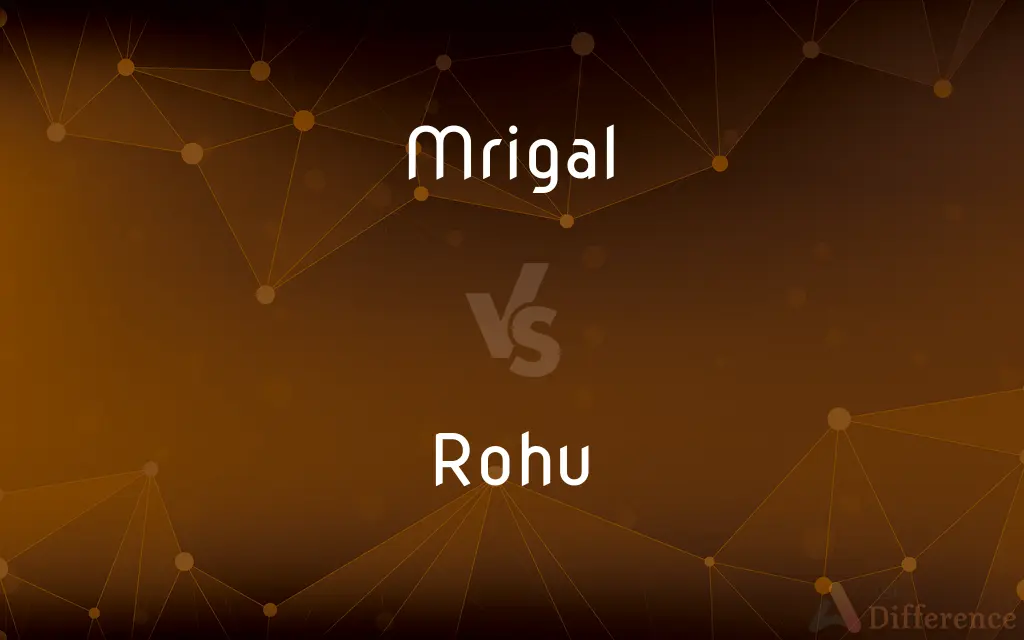Mrigal vs. Rohu — What's the Difference?
By Tayyaba Rehman & Maham Liaqat — Updated on April 2, 2024
Mrigal is primarily cultivated for its tender meat and adaptability in various water bodies, while Rohu is valued for its distinctive flavor and prominence in aquaculture.

Difference Between Mrigal and Rohu
Table of Contents
ADVERTISEMENT
Key Differences
Mrigal (Cirrhinus cirrhosus) is a freshwater fish known for its fast growth and hardiness, thriving in varied environments, whereas Rohu (Labeo rohita) is a sought-after species in South Asian aquaculture, celebrated for its taste and nutritional value. Both species are integral to aquaculture, but Mrigal's adaptability allows it to be cultivated in diverse water conditions, including slightly brackish water, while Rohu prefers freshwater habitats and is more specific in its environmental needs.
In terms of diet, Mrigal primarily feeds on detritus and vegetation, contributing to its lower placement in the aquatic food chain, whereas Rohu, being a column feeder, consumes phytoplankton and zooplankton, making it an important species for controlling algae in water bodies. This dietary difference influences the aquaculture practices for each fish, with Mrigal often being used in polyculture systems to improve water quality.
Mrigal can be distinguished by its more streamlined body and a less pronounced hump near the head compared to Rohu. Rohu is known for its prominent hump and a more rounded body shape, characteristics that are often preferred by consumers in South Asia for aesthetic and culinary reasons.
The market demand for Rohu is generally higher than for Mrigal, primarily due to its flavor profile and cultural significance in regional cuisines. This demand influences the aquaculture practices, with Rohu often fetching a higher price in the market. However, Mrigal's resilience and lower production costs make it an attractive option for aquaculture operations focused on efficiency and sustainability.
Both Mrigal and Rohu play crucial roles in polyculture systems, a sustainable aquaculture practice that mimics natural ecosystems. Mrigal, being a bottom feeder, helps in reducing the accumulation of waste and controlling algae growth, while Rohu, as a column feeder, contributes to the overall health of the water body by consuming different types of plankton.
ADVERTISEMENT
Comparison Chart
Habitat
Thrives in diverse environments, including slightly brackish water.
Prefers freshwater habitats.
Diet
Feeds on detritus and vegetation, playing a role in maintaining water quality.
Consumes phytoplankton and zooplankton, controlling algae in aquaculture ponds.
Physical Appearance
Streamlined body with a less pronounced hump near the head.
Rounded body with a prominent hump near the head.
Market Demand
Generally lower than Rohu, but valued for its adaptability and lower production costs.
Higher, due to its flavor and cultural significance in regional cuisines.
Role in Aquaculture
Often used in polyculture systems to improve water quality by reducing waste and controlling algae growth.
Important for controlling algae and maintaining the health of the aquaculture environment through its diet.
Compare with Definitions
Mrigal
A freshwater fish known for its rapid growth and adaptability to diverse aquatic environments.
The Mrigal carp is widely cultivated in South Asia due to its hardiness and adaptability.
Rohu
Characterized by its rounded body and prominent hump, making it visually distinctive.
The distinctive shape of Rohu is not only a mark of its identity but also a factor in its consumer preference.
Mrigal
Cultivated in both freshwater and slightly brackish waters, showing its versatile adaptability.
Farmers value Mrigal for its ability to thrive in varied water conditions, making it a resilient choice for aquaculture.
Rohu
Feeds on phytoplankton and zooplankton, contributing to the control of algae in ponds.
The diet of Rohu makes it an essential species in managing pond ecosystems and improving water quality.
Mrigal
Has a streamlined body and is less preferred in certain markets compared to other carps.
Despite its lower market demand, Mrigal is appreciated for its sustainability and ease of farming.
Rohu
Has a higher market demand compared to many other freshwater fishes due to its flavor.
In the market, Rohu often commands a higher price than other carps, attributed to its superior taste and texture.
Mrigal
Plays a significant role in polyculture systems, enhancing water quality and ecosystem health.
By integrating Mrigal into polyculture systems, aquafarmers can achieve more sustainable and efficient fish farming practices.
Rohu
Primarily found in freshwater environments and is sensitive to changes in its habitat.
Conservation of freshwater habitats is critical for the survival and cultivation of Rohu, emphasizing the need for sustainable aquaculture practices.
Mrigal
Consumes mainly detritus and vegetation, contributing to its role in ecosystem balance.
In aquaculture systems, Mrigal plays a crucial role in maintaining water quality by feeding on detritus.
Rohu
A key species in South Asian aquaculture, known for its taste and nutritional value.
Rohu is highly prized in culinary traditions, often being the fish of choice for special dishes.
Mrigal
Indian carp
Rohu
The rohu, rui, or roho labeo (Labeo rohita) is a species of fish of the carp family, found in rivers in South Asia. It is a large omnivore and extensively used in aquaculture.
Rohu
A freshwater fish, Labeo rohita, of the carp family, found throughout Asia.
Common Curiosities
Which fish has a higher market demand, Mrigal or Rohu?
Rohu generally has a higher market demand due to its distinctive flavor and cultural significance.
Can Mrigal and Rohu be distinguished by their physical appearance?
Yes, Mrigal has a more streamlined body with a less pronounced hump, while Rohu has a rounded body with a prominent hump.
Why are Mrigal and Rohu important in aquaculture?
They play crucial roles in polyculture systems, with Mrigal enhancing water quality and Rohu controlling algae through its diet.
What are the primary habitats of Mrigal and Rohu?
Mrigal can thrive in both freshwater and slightly brackish environments, while Rohu prefers freshwater habitats.
How do the diets of Mrigal and Rohu differ?
Mrigal feeds on detritus and vegetation, whereas Rohu consumes phytoplankton and zooplankton.
What are the challenges in farming Rohu compared to Mrigal?
Rohu requires more specific environmental conditions and quality water, making its cultivation more challenging than Mrigal.
What makes Mrigal adaptable to diverse water conditions?
Its ability to feed on a wide range of organic matter and tolerate slight salinity makes it highly adaptable.
How do Mrigal and Rohu contribute to sustainable aquaculture?
By integrating them into polyculture systems, they help in maintaining ecosystem balance and improving water quality.
How does Rohu's feeding behavior affect pond ecosystems?
By consuming plankton, Rohu helps in controlling algae blooms and maintaining water quality.
How does the diet of Mrigal benefit aquaculture ponds?
Its consumption of detritus and vegetation helps in reducing waste and controlling algae growth.
Why is Rohu preferred in South Asian cuisines?
Its unique taste and texture make it a favorite for traditional dishes and celebrations.
Is there a difference in the nutritional value between Mrigal and Rohu?
Both are nutritious, but their diets may influence their fatty acid profiles and thus their nutritional value slightly.
What factors influence the market price of Rohu?
Demand, culinary preferences, and its role in traditional cuisines significantly influence its market price.
What are the environmental considerations for cultivating Mrigal and Rohu?
Maintaining clean water and suitable habitats are crucial for both, with specific attention to water quality for Rohu.
Can Mrigal be used in integrated farming systems?
Yes, its adaptability and role in nutrient cycling make it suitable for integrated farming systems.
Share Your Discovery

Previous Comparison
Slave vs. Servant
Next Comparison
Lightness vs. DarknessAuthor Spotlight
Written by
Tayyaba RehmanTayyaba Rehman is a distinguished writer, currently serving as a primary contributor to askdifference.com. As a researcher in semantics and etymology, Tayyaba's passion for the complexity of languages and their distinctions has found a perfect home on the platform. Tayyaba delves into the intricacies of language, distinguishing between commonly confused words and phrases, thereby providing clarity for readers worldwide.
Co-written by
Maham Liaqat















































